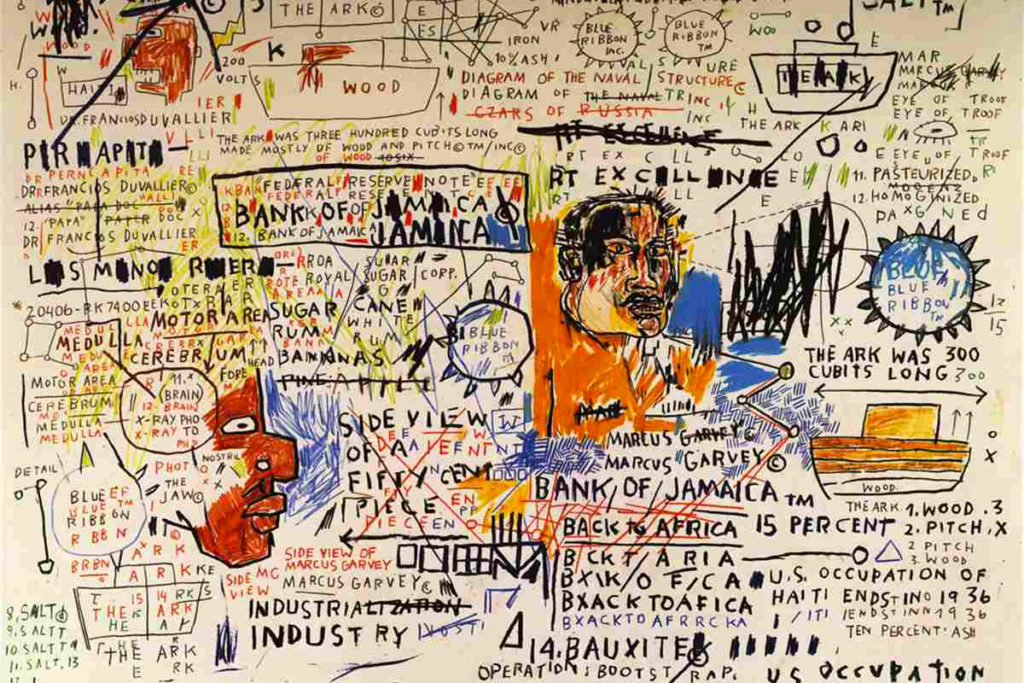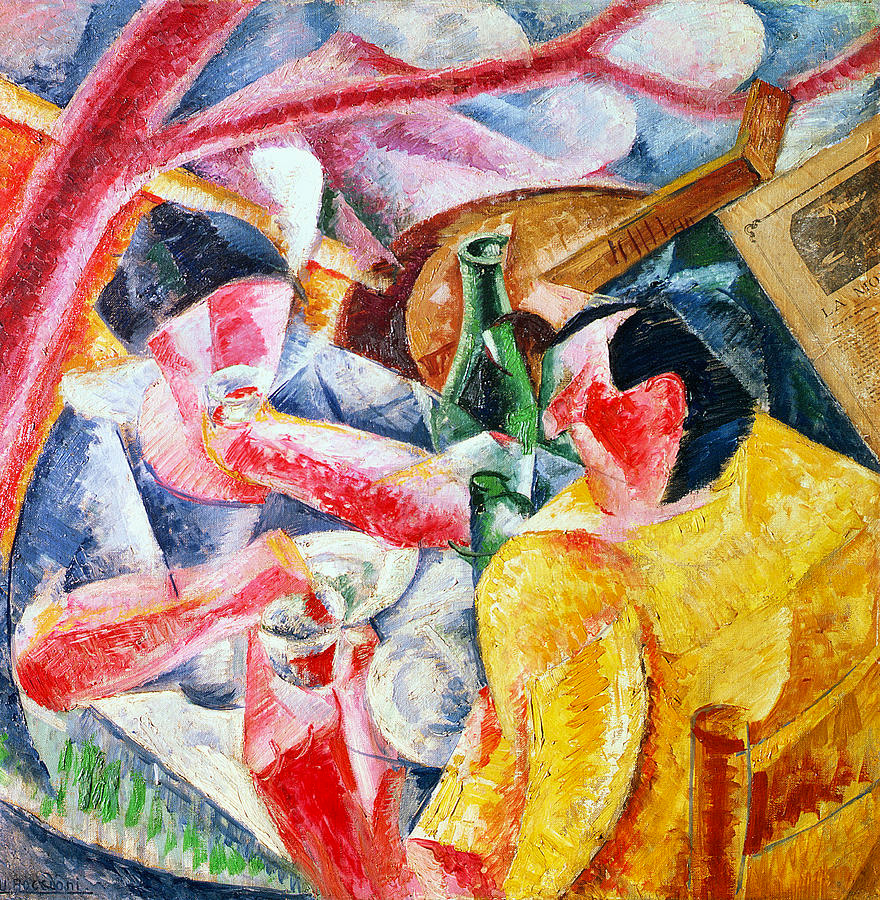 50 Cent Piece, by Jean-Michel Basquiat
50 Cent Piece, by Jean-Michel Basquiat
We generally think of art as beautiful, but perhaps nonessential. Or it’s essential for the soul, if you go for that sort of thing. “Man does not live by bread alone,” and so forth. But we don’t think of it as essential for survival. At a meetup the other day, an artist even told me that they thought art served needs fairly high on Maslow’s Hierarchy. But, you know, there is evolution and natural selection. And selection pressure doesn’t allow maladaptive traits to hang on. Why haven’t the fools who waste time and energy on art been outcompeted and removed from the gene pool by wiser, soulless working machines? It’s a conundrum, it is.
Go ask our venerable futurist thought leader, Robin Hanson, and he will tell you, oh well, this is the Dreamtime, don’t you know? This rich, industrialized era is an aberration and we will soon return to the Malthusian equilibrium that has dominated all human and animal life throughout time. Malthus envisions us as stupid animals, reproducing until we’ve eaten every spare scrap of food around us and are forced into abject misery. I get chafed at the very mention of Malthus and his empirically bereft theories, but that’s a battle for another day. I find it generally makes sense to listen carefully to Hanson, and I try to understand what he has to say.
But then Scott Alexander, the bard of the rationalists, came out with his Moloch piece a few years ago, and shaped an entire narrative incorporating these Malthusian and Hansonian ideas, and really it was just too much for me. He is a great writer, this Alexander, and the rationalists all around me consumed his narrative with relish, experiencing not the slightest indigestion. I was left to gnash my teeth quietly off in the hinterlands of Oakland, wrestling with my intuition. I tasted of this Moloch soup, but I could not keep it down.
How can art be a maladaptive thing? Evolution doesn’t allow maladaptive traits to persist in populations. Even if it’s only a very small handicap, evolution will remove a trait over time. But there are periods of relaxed selection, and these correspond to explosions of diversity. Weeds will grow while the gardener sleeps. So perhaps that explains it. Oh, sad story. That thing you value, that song that compels you to dance, that dance you do in spastic ecstasy, are all for naught. The gardener will soon awaken and trim such foolishness away. Selective pressure will increase once again, and all of us who wasted effort dancing will end up in the soup pots of those who didn’t squander their fitness on such frivolity.
And if we look at the world in a certain way, it looks like it’s filled with maladaptive behavior. Surely this is a time of superstimuli and dysgenic birth control and porn. The wise look sadly on and see relaxed selection at work. Tisk, tisk, such a pity. But, you know, a proper skeptic kicks the tires of his own conceptual framework now and then, and, hark, what is this we find? A crack in the narrative? Do you know what looks a lot like relaxed selection? I will tell you, it’s positive adaptation. How confident can we be that we actually know what’s adaptive and what isn’t? Surely having the most children possible is the most adaptive strategy, yes? Then how did we end up with various parental investment strategies? (Some people having lots of kids and giving them only a little attention, and some people having only a few kids and giving them lots of attention.) Hmm. Wait a minute! Maybe even frivolous art is a POSITIVE adaptation. Not a thing to feed the soul, but a thing to feed the belly.
Some people think that the only way that art could be adaptive is if it helped an artist personally by making them more attractive to mates or allowing them to trade art for food. But let’s look at very early human art, such as the drawings cavemen made when they were going to hunt large prey. These drawing might have been hunting plans. And, in that case, the tribes who made these drawings (art) would outcompete those that didn’t. And yes, like the biologist E.O. Wilson, I believe that there is such a thing as groups outcompeting other groups.
Art has beauty that draws us to it and this connects us as tribes. When we dance together, we form bonds. And this was as true around paleolithic campfires as it is today at Gilman Street punk rock shows. So here I will present to you some mechanisms by which art may be a positive adaptation.
1) Art Speaks the Language of the Subconscious
A few years ago, I went to a rationality workshop put on by CFAR. At this workshop, there was much talk of Kahneman’s model of two major ways in which the mind works. System 1 roughly corresponds to the subconscious or the preconscious mind, and is the realm of fast, effortless thinking, intuition, and emotions. System 2 is conscious thought and is slow and effortful and where we expect logic and planning to occur. Surprisingly to me, CFAR seemed more concerned with System 1 than with System 2. System 1 seems to be where motivation comes from. So a lot of effort was devoted to getting System 1 to align with System 2 goals, so that you actually feel motivated to do things today which have payoffs far in the future.
What the hell does this have to do with art being adaptive? I’m glad you asked. See, the instructors at CFAR think one way of getting messages into System 1 is to use very exaggerated and sense-based imagery. So if you want to remember to check the mail when you get home, perhaps you should picture a massively distorted mailbox and imagine the crisp scent of paper. Isn’t it interesting how much art has these same properties? Novels contain a lot of exaggerated language about sensory experiences and vocals contain exaggerated emotion. It may be that art is memorable to the degree that it takes advantage of this exaggerated, System 1 communication. And it is a unique channel in this regard. Scientific or mathematical writing is fairly bereft of this.
2) Art Populates the Database of Experience with Novel Patterns
Another interesting CFAR exercise was CoZE (Comfort Zone Expansion). The goal was to get everyone to try new things and gain new experiences. System 1 functions as a pattern matcher, and populating your subconscious with more patterns will make it more powerful. So you can go and try new things all the time, which is hard. OR you can go and virtually gain new experience by reading stories, listening to songs, or looking at crazy paintings and sculptures. And who knows what use these strange patterns will end up serving? Musk disdains such metaphorical thinking, but see how much technology mimics the things we observe in nature. Bell’s telephone was inspired by the workings of the inner ear, and deep learning is patterned after the neural networks of our own brains.
Perhaps reading about how a love affair goes awry in Shakespeare will inform our own love lives. In The Better Angels of Our Nature, Pinker suggests that one mechanism of our evolving morality might be literature and the arts, which gives us insights into the minds of others. Or, stranger yet, perhaps we will hear some weird pattern in a song that inspires us to create a new technology that no one has imagined yet.
3) Art Reduces Communication Costs
Aside from the raw potential of art to populate our subconscious with patterns and inspire us, art often serves as a substrate for coordination. Entire subcultures have arisen around shared admiration for music or comic books. How does art facilitate this coordination at punk rock shows or cosplay conventions? One mechanism is the reduction of communication costs. Art provides narratives that allow people to situation themselves within. Punk rock is an expression of postmodern dissatisfaction with the fakery of conformist, consumer culture. Punks don’t need to explain all of this to one another (although they certainly delight in doing so) because they can refer to a single song to express an entire range of ideas.
Eliezer Yudkowsky has used art to good effect to coordinate an entire subculture of rationalists around his HPMOR fan fiction. I haven’t read it myself, but I don’t know how many times I’ve heard a rationalist refer to Quirrel and have seen the others in the group nod sagely. If only I had read HPMOR, I could have gotten the point. Entire modes of approaching problems can be summed up in a single fictional character.
We even see narratives at work coordinating corporate culture. Peter Thiel is famous for this, naming his companies after artifacts from Tolkien’s world. Palantir is a seeing stone in Tolkien’s fiction, created for good, but turned to evil. Palantir, the company, offers analytic software to the government and perhaps Thiel wants to warn his people to heed the cautionary tale that Tolkien intended. Mithril Capital references Tolkien’s precious metal, which has a beauty that never tarnishes or grows dim. Not hard to see what sort of investments they would be seeking.
Of course every field has shared jargon that compacts a lot of bigger ideas and serves the purpose of reducing communication costs. But the beauty of art is that its metaphorical nature makes this jargon more generalizable, allowing it to cut across disciplines.
4) Art Appreciation Demonstrates Shared Values
Art has also served as a way to demonstrate shared values. See how closely art was tied to the church in the Middle Ages. Or how gospel songs bound together the protesters of the Civil Rights Movement. It seems a shame that modern artists aren’t providing the Black Lives Matter movement with more compelling art to disarm their right wing opponents. And of course this is true in subcultures as well. Fellow goths know that darkness lives in your soul when you display your Joy Division t-shirt.
So art really has all sorts of traits that make it seem like a positive adaptation, not just a maladaptive trait that survives due to weak selection pressure. So what? Well, I know that I have neglected art in my own life recently, and this thesis makes me see it in a new light. Art isn’t merely a pleasant diversion. Art appreciation binds us to others in our tribe and populates our subconscious with powerful experiences. It serves as a substrate for coordination that sinks deeply into our souls (err, System 1’s) and can inspire and motivate us like no mere mission statement. So we should take up art, not only for its beauty, but also with a proper concern for our own self-interest. Art is a powerful superweapon. Take that, Moloch.

 Under the Pergola at Naples, Umberto Boccioni
Under the Pergola at Naples, Umberto Boccioni